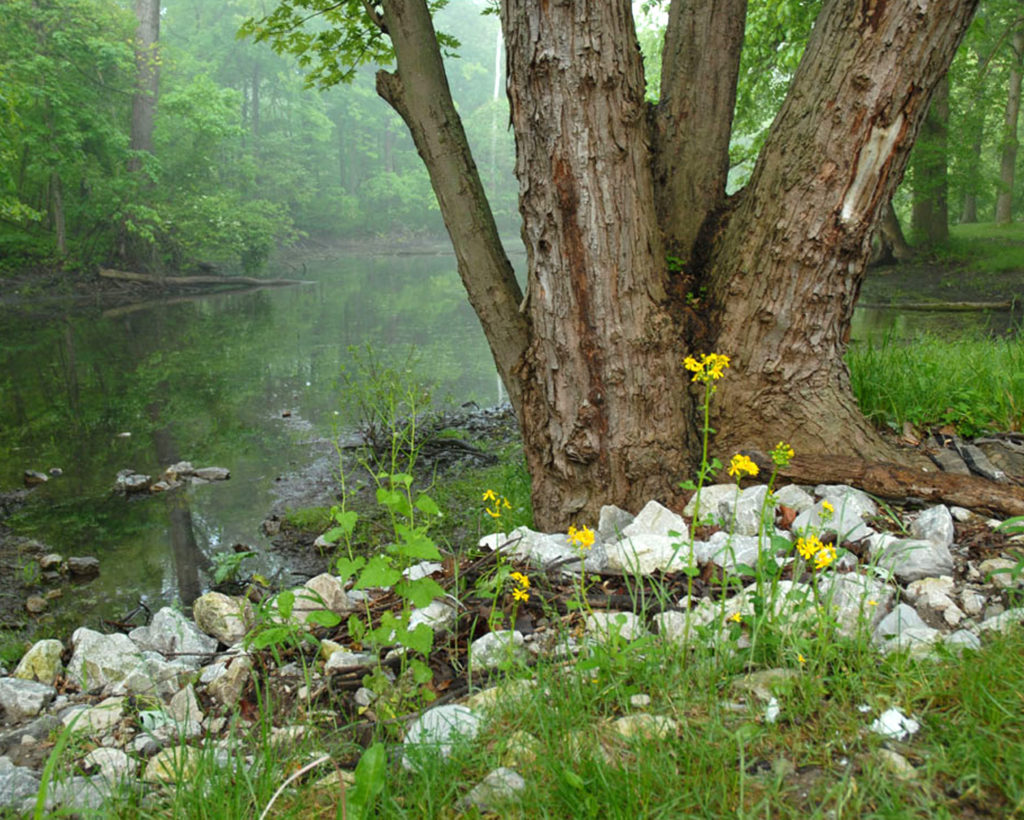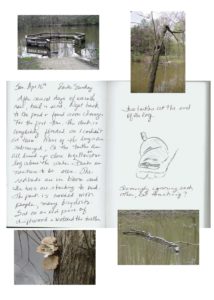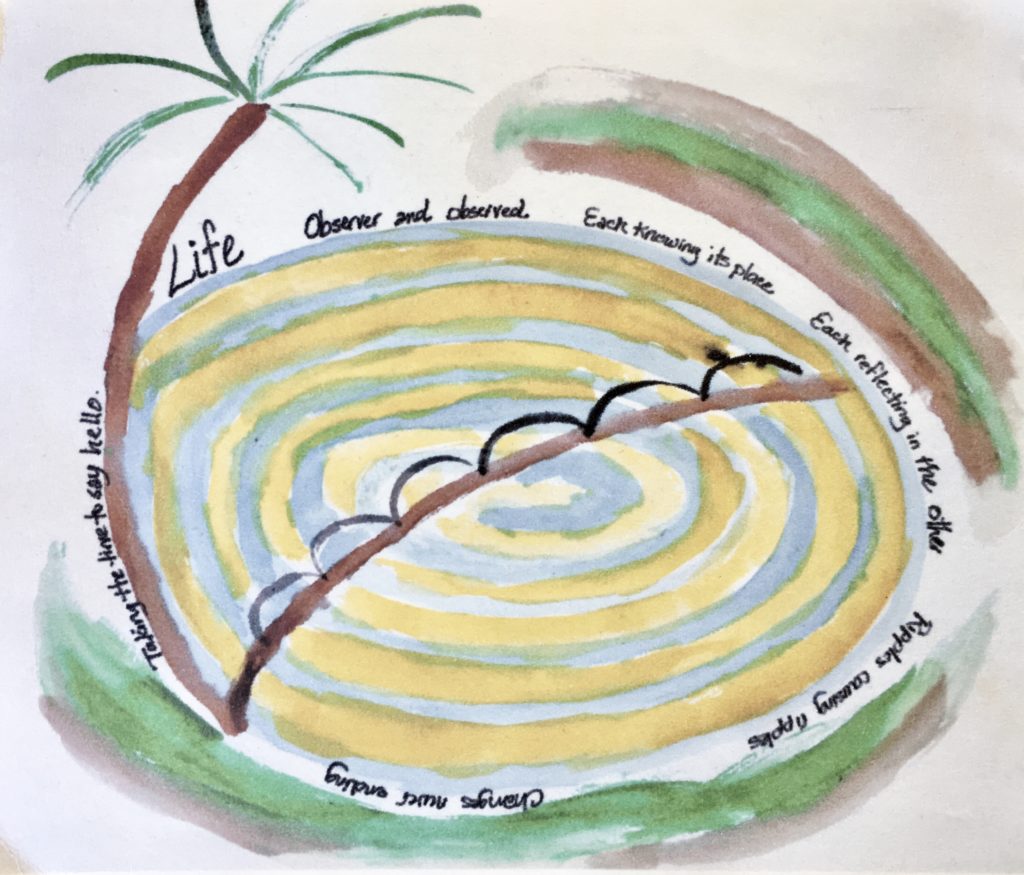
Last week, I told you about my eco-awakening in childhood and encouraged you to reflect on your own. I’ve had several eco-awakenings in adulthood and today I’ll share one that occurred while doing a Masters degree in Earth Literacy more than ten years ago. The entire educational experience was an awakening, but one assignment in particular stands out because it combined creativity and science. The instructor, Liza Hyatt, asked us to choose a natural place that we could visit on a regular basis over the semester, at minimum once a week, for at least twenty minutes each time. We would get to know this place by using eight types of intelligence (Gardner). In other words, we would experience our place from not only a scientific/linguistic context, but with a creative mindset (writing, singing, dancing, creating art). We would not be strictly independent observers but we would hopefully develop a relationship and sense of intimacy with the place. This certainly happened for me.
I lived in Indianapolis at the time and chose a very small pond in a city park near my home. The time period covered February through April, 2006. For my first visits, there was snow on the ground and by the end we had springlike weather. During this period, this quote from my reading stood out. Francois Matthes, a U.S. Geologist, said “the fullest appreciation of any landscape comes only when one is also alive to its meaning.” The meaning comes from seeing the whole and I did experience this place as an entire ecosystem, not just the pond. This place was home to the surrounding trees and many species, including ducks and turtles. The water nourished both plants and animals. I developed a great fondness for this place which continues to this day. Below I describe how I used the eight intelligences.
The Eight Intelligences
 Verbal-Linguistic: As one who thinks more in pictures and concepts, I often have trouble putting my ideas into words. However, I had a special journal for this assignment and enjoyed writing and drawing regularly, even trying my hand at the odd poem. Sometimes I collected a leaf or feather and pasted it in. When I re-read my entries, it takes me right back to that time. I not only wrote about the place. It was also a good time to reflect on what was happening in my life and the pond provided company.
Verbal-Linguistic: As one who thinks more in pictures and concepts, I often have trouble putting my ideas into words. However, I had a special journal for this assignment and enjoyed writing and drawing regularly, even trying my hand at the odd poem. Sometimes I collected a leaf or feather and pasted it in. When I re-read my entries, it takes me right back to that time. I not only wrote about the place. It was also a good time to reflect on what was happening in my life and the pond provided company.
Logical-Mathematical: The science part came easily for me. My bachelor’s degree is in Mathematics and I love considering the findings coming out of quantum physics about the interconnectedness of all things. This theme of connectedness came to the forefront during my time at the pond and many of my photographs revealed those connections. I did research on the local trees and turtles.
Visual-Spatial: While I’m not a painter or sculptor, I do enjoy drawing and, of course, taking photographs. Through photography, I try to convey not just the literal image, but also the feelings evoked by the image or the relationship between photographer and subject.
Bodily-Kinesthetic: This is an area where I had to push myself. A friend and I had exercised to an African Healing Dance Video and I tried to use that experience at the pond, as a way to show gratitude for my time there. I also walked around the pond, felt the bark on the trees, and lay on my back to soak up the sun and the sounds.
Musical-Rhythmic: Music is truly a necessity in my life and the sounds at the pond became a symphony. Birds, ducks, people, cars, water, and silence, all contributed to the soundtrack of the pond. I listened intently and recorded what I heard.
Interpersonal: In sharing my assignment with friends, one invited me to experience her African Healing Dance Video, and another shared her knowledge of Corita Kent. At the pond, I sometimes encountered other people and we shared a greeting or a smile. Mostly though, my awareness of the animals and their awareness of me became the most profound connections. The turtles got to know me as someone familiar and trustworthy.
Intrapersonal: I enjoy time alone, so being at the pond was invigorating for me. It helped me to recharge, and put my thoughts into perspective. I had time to reflect on the pond and life.
Naturalist: Although I love being in nature, I am not one to collect things or to know the details of each animal, plant, or tree I come across. I did identify some of the trees at the pond and specifically learned more about sycamores, prevalent in that park. I also learned much more about turtles – what their lives are like, their ancient history and resiliency.
Stages of the Creative Process
At the end of the semester, we were asked to summarize our time at our chosen place through a written essay, a scientific paper on a particular species from our place, and finally an art project of our choosing. For the art piece, we had to describe how it came to be through the stages of the creative process.
Desire, longing: I was excited to do this assignment, and decided to create something outside of my comfort zone of photography. I’ve always had a strong desire to understand the order behind the universe, and how we’re all connected to everything else. The pond attracted me because I enjoy being near water, however, I also knew that this pond became quite scummy and unattractive in the summertime. I didn’t expect there to be so much life there.
Risk: While at the pond, I took some creative risks, although nothing too extreme. I danced, sang, sketched, and talked to people. Some of these activities made me a little uncomfortable. I tried to limit my photography to the end of each visit, although the camera does help to reveal what is going on in my subconscious. My goal was to create something that comes from my soul and to not be afraid of negative feedback. I also took the time to just be, to wait out the creative process, embrace the uncertainty, and not think too much about the finished product. This was a risk in that I occasionally feared that I would not be able to come up with anything to create.
Mystery, Magic, Aliveness: At the pond, I spent a lot of time watching the ripples in the water. Everything we create from our true self will have its own ripple effect. The pond was constantly alive and changing. It was much more full of life than I ever expected. And, it was always unpredictable. One day 25 turtles would be out, the next time none. One time four butterflies had a party, something I never saw again. Once and only once I saw a beaver. During this time I was reading about co-creation in nature and co-creation in organizations. And, I was seeing this in action at the pond and feeling it happen within me.
Initiation and Maturation: With all of the reading and writing on evolution and co-evolution, my worldview was slowly readjusted. Many of my previously held beliefs from a sociocultural and religious perspective were in a state of flux. My task was to experience the pond and to see how it fit with my new learnings.
Community, Communion: Although I am somewhat of a loner at times, I’m also drawn to community. As messy as it can be sometimes, I truly believe that it is necessary for survival. The pond reinforced this idea as I saw butterflies cavorting and turtles basking in the sun together. During that time, I heard David Korten speak at Butler University, and what stood out for me in his talk was that “Relationships are the foundation of everything.” This is so true and I saw this at the pond in different ways. I was drawn to reflections and noticed that everything is always reflected in the water. Nothing gets left out.
Death: is a part of life and feeds life. I experienced many little deaths during my time at the pond. There were personal deaths when family members were suffering and I could not enjoy the pond as easily. I deleted many photographs and had thoughts that went nowhere. I experienced the pond during the winter when much of the life there was dormant or in hibernation. Spring brought long-awaited new life. I started composting my food waste during this time and was amazed at how satisfying it is to put waste into my compost pail and know that it will be returning to the earth as food for new life. My waiting time was like a death. I experienced emptiness in the beginning, not knowing what I was meant to create. When I finally began to create my project many pages were scrapped yet each new page built on the one previous. What I ended up with was very different from what I started with but the end product contained seeds of the original.
Transformation: The pond provided a visual example of constant transformation, which was evident in my photographs. As for me, this assignment changed me and my relationship with the pond. And, this is not the end of my transformation, just one step on the journey. My transformation came about as a process of re-imagining my worldview. Certain ideas such as the importance of community, the sacredness of life, the effects of actions, and that everything is constantly changing, were reaffirmed. Other ideas such as human primacy, and how we should live on this earth, were challenged. I feel the transformation happening within and realize that it is a continuous process. Each new learning builds on the others, and we are always evolving to the next step in our consciousness. Where it will lead, I don’t know. But I trust in the process.
At first I thought there was little life in the pond. How silly of me! I soon discovered ducks, squirrels, turtles, frogs, dragonflies, butterflies, birds, lizards, beaver, etc. Who knows what more was living below the surface of the water, in the soil at the edge of the pond, that was not visible to my limited eyes. The pond was teeming with life. Things are not always as they seem. Over the three months visiting, sketching, writing, and being, there we’re certain themes that kept popping up. They were:
• That I am as much observed as observer.
• All of life is constantly changing.
• Life is full of life and full of surprises.
• Ripples represent how actions affect others.
• There is value in basking.
• All life desires to be in community.
• Everything is reflected in everything else.
• Reflection brings connection.
• Being in nature is healing.
• It is good to know your place.

Life. observer and observed. Each Knowing it’s place. Each reflecting in the other. Ripples causing ripples. Changes never ending. Taking the time to say hello.
My teacher said that this piece was profound in its simplicity. The value of waiting became apparent about halfway through my time there. Where my mind had seemed to be empty of ideas, suddenly thoughts were coming to me seemingly out of nowhere. The subconscious is an amazing thing. Circles in the form of water ripples, algae patterns, and the web of life became another theme. At the same time I was reading “Leadership and the New Science” (paid link) by Margaret Wheatley. In it Andreas Feininger speaks of the spiral being one of nature’s basic forms of design. Wheatley described the spiral in art as being an archetype for the experience of change; creation followed by dissipation and then new order.
The art component of this assignment was not only very interesting and fun but also very much needed as a balance to the fairly heavy science component. I really appreciated being “forced” to take time out of my week to go to my place and just be. Fortunately the turtles at my place demonstrated this process of waiting time and time again. Artist Ted Orland says, “Creativity is not the sole province of artmaking. In fact creativity is not even about artmaking per se – it is about seeing.” I learned to see the pond in a whole new way and developed a relationship with it and the animals who call it home.
I share this project with you in the hope that you might try something similar. Today, I live in a different place and my current project involves visiting Lake Ontario throughout the year and seeing it in all of its many manifestations.